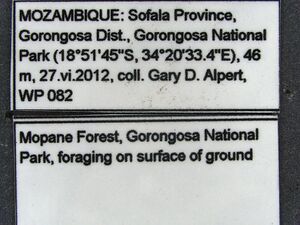Anochetus levaillanti
This species forages singly in open areas during the day and nest entrances are small openings in the soil. Workers can be seen bringing back small prey items to the nest.
| Anochetus levaillanti | |
|---|---|

| |
| Scientific classification | |
| Kingdom: | Animalia |
| Phylum: | Arthropoda |
| Class: | Insecta |
| Order: | Hymenoptera |
| Family: | Formicidae |
| Subfamily: | Ponerinae |
| Tribe: | Ponerini |
| Genus: | Anochetus |
| Species: | A. levaillanti |
| Binomial name | |
| Anochetus levaillanti Emery, 1895 | |
Identification
First gastric tergum with rugulose sculpture in addition to the punctures over much of its anterior and discal surfaces, rendering it opaque, or at most only weakly shining; vertex continuously striate and opaque to nuchal carina over a wide median area of vertex; pronotal disc entirely striate and opaque.
Keys including this Species
Distribution
Latitudinal Distribution Pattern
Latitudinal Range: -16.30083333° to -34.06667°.
| North Temperate |
North Subtropical |
Tropical | South Subtropical |
South Temperate |
- Source: AntMaps
Distribution based on Regional Taxon Lists
Afrotropical Region: Eritrea, Mozambique, Namibia, South Africa (type locality), Zimbabwe, Zimbabwe.
Distribution based on AntMaps
Distribution based on AntWeb specimens
Check data from AntWeb
Countries Occupied
| Number of countries occupied by this species based on AntWiki Regional Taxon Lists. In general, fewer countries occupied indicates a narrower range, while more countries indicates a more widespread species. |

|
Estimated Abundance
| Relative abundance based on number of AntMaps records per species (this species within the purple bar). Fewer records (to the left) indicates a less abundant/encountered species while more records (to the right) indicates more abundant/encountered species. |

|
Biology
This species forages singly during the day in open areas. Individual foragers can be seen bringing a series of small prey items back to their nest. Colony size is estimated to be less tthan 100 workers based upon the number of workers returning to the nest. Workers are timid and "freeze" if disturbed.
Castes
Worker
       
| |
| . | |
Nomenclature
The following information is derived from Barry Bolton's Online Catalogue of the Ants of the World.
- levaillanti. Anochetus levaillanti Emery, 1895h: 21 (w.) SOUTH AFRICA.
- Type-material: holotype (?) worker.
- [Note: no indication of number of specimens is given.]
- Type-locality: South Africa: Transvaal, Hamman’s Kraal, i.-iv.1893 (E. Simon).
- Type-depository: MSNG.
- Arnold, 1915: 108 (q.).
- Status as species: Forel, 1910c: 248; Emery, 1911d: 109; Forel, 1913a: 108; Arnold, 1915: 107 (redescription); Wheeler, W.M. 1922a: 791; Finzi, 1939a: 154; Brown, 1978c: 557, 594; Bolton, 1995b: 64; Madl, 2019: 16.
- Distribution: Eritrea, South Africa, Zimbabwe.
Unless otherwise noted the text for the remainder of this section is reported from the publication that includes the original description.
Description
References
- Arnold, G. 1915. A monograph of the Formicidae of South Africa. Part I. Ponerinae, Dorylinae. Ann. S. Afr. Mus. 14: 1-159 (page 108, queen described)
- Brown, W. L., Jr. 1978c. Contributions toward a reclassification of the Formicidae. Part VI. Ponerinae, tribe Ponerini, subtribe Odontomachiti. Section B. Genus Anochetus and bibliography. Stud. Entomol. 20: 549-638 (page 594, see also)
- Emery, C. 1895i. Voyage de M. E. Simon dans l'Afrique australe (janvier-avril 1893). 3e mémoire. Formicides. Ann. Soc. Entomol. Fr. 64: 15-56 (page 21, worker described)
- Gomez, K., Hawkes, P.G., Fisher, B.L. 2023. Ant endemicity in the highlands and escarpments of Angola and Namibia (Hymenoptera, Formicidae). Monograph on Endemism in the Highlands and Escarpments of Angola and Namibia. Namibian Journal of Environment 8, 197-203.
References based on Global Ant Biodiversity Informatics
- Botes, A., M.A. McGeoch, H.G. Robertson, A. van Niekerk, H.P. Davids and S.L. Chown. 2006. Ants, altitude and change in the northern Cape Floristic Region. Journal of Biogeography 33:71-90
- Brown Jr., W.L. 1978. Contributions toward a reclassification of the Formicidae. Part VI. Ponerinae, Tribe Ponerini, Subtribe Odontomachiti, Section B. Genus Anochetus and Bibliography. Studia Entomologia 20(1-4): 549-XXX
- Brown W.L. Jr. 1978. Contributions toward a reclassification of the Formicidae. Part VI. Ponerinae, tribe Ponerini, subtribe Odontomachiti. Section B. Genus Anochetus and bibliography. Studia Ent. 20(1-4): 549-638.
- CSIRO Collection
- Dean, W. R. J. and Bond, W. J. 1990. Evidence for Rapid Faunal Changes on Islands in a Man-Made Lake. Oecologia. 83:388-391.
- Emery C. 1911. Hymenoptera. Fam. Formicidae. Subfam. Ponerinae. Genera Insectorum 118: 1-125.
- Finzi B. 1939. Materiali zoologici dell'Eritrea raccolti da G. Müller durante la spedizione dell'Istituto Sieroterapico Milanese e conservati al Museo di Trieste. Parte III. Hymenoptera: Formicidae. Atti del Museo Civico di Storia Naturale di Trieste 14: 153-168.
- Forel A. 1910. Ameisen aus der Kolonie Erythräa. Gesammelt von Prof. Dr. K. Escherich (nebst einigen in West-Abessinien von Herrn A. Ilg gesammelten Ameisen). Zoologische Jahrbücher. Abteilung für Systematik, Geographie und Biologie der Tiere 29: 243-274.
- IZIKO South Africa Museum Collection
- Lindsey P. A., and J. D. Skinner. 2001. Ant composition and activity patterns as determined by pitfall trapping and other methods in three habitats in the semi-arid Karoo. Journal of Arid Environments 48: 551-568.
- Robertson H. G. 2000. Formicidae (Hymenoptera: Vespoidea). Cimbebasia Memoir 9: 371-382.
- Tshinguvho T. E., W. R. J. Dean, and H. G. Robertson. 1999. Conservation value of road verges in the semi-arid Karoo, South Africa: ants (Hymenoptera: Formicidae) as bio-indicators. Biodiversity and Conservation 8: 16831695
- Wheeler W. M. 1922. Ants of the American Museum Congo expedition. A contribution to the myrmecology of Africa. VIII. A synonymic list of the ants of the Ethiopian region. Bulletin of the American Museum of Natural History 45: 711-1004



